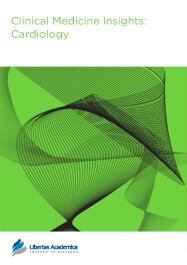

Publication Date: 07 Sep 2010
Type: Original Research
Journal: Clinical Medicine Insights: Cardiology
doi: 10.4137/CMC.S5892

The U wave is still an electrocardiographic deflection of enigmatic origin. Numerous hypotheses on its origin have been formulated, but to date none has been conclusively proven. Recently, a report described the first case of bifid (or notched) U waves. Until then this phenomenon has only been described in the T wave. This is the first report of double U waves—two separate deflections, ascribed to an accessory papillary muscle.
Hypothesis: The presence of a double U wave will be associated with an accessory papillary muscle (s).
Materials and methods: This is a retrospective analysis of 4729 patient files of patients who were evaluated at a cardiology practice. The 12-lead surface electrocardiogram was evaluated for the possible presence of a double U wave. In cases where a double U wave was found, the transthoracic echocardiogram was then scrutinized for the presence of an accessory papillary muscle.
Results: A total of 3 cases of a double U wave were found. In every case an accessory papillary muscle was clearly seen on the transthoracic echocardiogram.
Conclusion: A double U wave is a new variant of an old electrocardiographic deflection of enigmatic origin. This variant may be associated with an accessory papillary muscle.
PDF (3.59 MB PDF FORMAT)
RIS citation (ENDNOTE, REFERENCE MANAGER, PROCITE, REFWORKS)
BibTex citation (BIBDESK, LATEX)
XML
PMC HTML
Clinical Medicine Insights: Cardiology is very much conscious of time. Every step is done thoroughly and rapidly. The reviewers' comments are constructive. There is regular contact with the authors, providing explanations where necessary. The visibility also enjoyed by one's article once it is published is worthy of note. Thanks for making publishing with you so easy and enjoyable.

All authors are surveyed after their articles are published. Authors are asked to rate their experience in a variety of areas, and their responses help us to monitor our performance. Presented here are their responses in some key areas. No 'poor' or 'very poor' responses were received; these are represented in the 'other' category.See Our Results
Copyright © 2013 Libertas Academica Ltd (except open access articles and accompanying metadata and supplementary files.)
FacebookGoogle+Twitter
PinterestTumblrYouTube